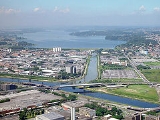
Guarapiranga
Encyclopedia
The Reservoir of Guarapiranga (Represa de Guarapiranga) is a reservoir
in the southern area of the city of São Paulo
, in the State of São Paulo
, Brazil
.
, and Embu-Guaçu
. It was constructed originally to attend the necessities of the production of electrical energy in the Parnaíba Hydroelectric
generating plant. It is currently utilized for the water supply for the Greater São Paulo
by the Companhia de Saneamento Basico do Estado de São Paulo (SABESP)
, a Brazilian state owned utility that provides water and sewage services. Guarapiranga is also utilized as a flood control mechanism and as a place of leisure. There are artificial beaches and marina
s in the reservoir's peripheral areas.
Reservoir
A reservoir , artificial lake or dam is used to store water.Reservoirs may be created in river valleys by the construction of a dam or may be built by excavation in the ground or by conventional construction techniques such as brickwork or cast concrete.The term reservoir may also be used to...
in the southern area of the city of São Paulo
São Paulo
São Paulo is the largest city in Brazil, the largest city in the southern hemisphere and South America, and the world's seventh largest city by population. The metropolis is anchor to the São Paulo metropolitan area, ranked as the second-most populous metropolitan area in the Americas and among...
, in the State of São Paulo
São Paulo (state)
São Paulo is a state in Brazil. It is the major industrial and economic powerhouse of the Brazilian economy. Named after Saint Paul, São Paulo has the largest population, industrial complex, and economic production in the country. It is the richest state in Brazil...
, Brazil
Brazil
Brazil , officially the Federative Republic of Brazil , is the largest country in South America. It is the world's fifth largest country, both by geographical area and by population with over 192 million people...
.
Construction
The Reservoir of Guarapiranga was constructed in 1906 by the São Paulo Tramway, Light and Power Company, also known as "Light", which was the company responsible for the regions supply of electrical energy at that time. In 1928, Guarapiranga began being used as a reservoir for potable water distribution.Water supply
The reservoir is supplied by the River Guarapiranga and other smaller rivers and brooks, traversing areas of the cities of São Paulo, Itapecerica da SerraItapecerica da Serra
Itapecerica da Serra is a municipality in the state of São Paulo in Brazil. The population in 2006 is 162,239, the density is 1,071.2 inh./km² and the area is 151 km²...
, and Embu-Guaçu
Embu-Guaçu
Embu-Guaçu is a municipality in the state of São Paulo in Brazil. The population in 2006 is 72,170 and the area is 155 km². The elevation is 408.22 m....
. It was constructed originally to attend the necessities of the production of electrical energy in the Parnaíba Hydroelectric
Hydroelectricity
Hydroelectricity is the term referring to electricity generated by hydropower; the production of electrical power through the use of the gravitational force of falling or flowing water. It is the most widely used form of renewable energy...
generating plant. It is currently utilized for the water supply for the Greater São Paulo
Greater São Paulo
The Greater São Paulo is a nonspecific term for one of the multiple definitions the large metropolitan area located in the São Paulo state in Brazil.-Definitions:-Metropolitan Area:...
by the Companhia de Saneamento Basico do Estado de São Paulo (SABESP)
Sabesp
Sabesp is a Brazilian state owned utility that provides water and sewage services to residential, commercial and industrial use in the São Paulo and in 364 of the 645 municipalities in São Paulo State, Brazil...
, a Brazilian state owned utility that provides water and sewage services. Guarapiranga is also utilized as a flood control mechanism and as a place of leisure. There are artificial beaches and marina
Marina
A marina is a dock or basin with moorings and supplies for yachts and small boats.A marina differs from a port in that a marina does not handle large passenger ships or cargo from freighters....
s in the reservoir's peripheral areas.

